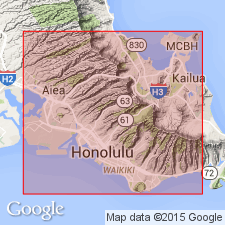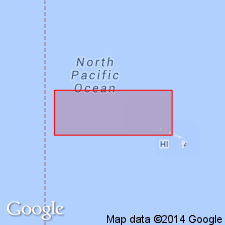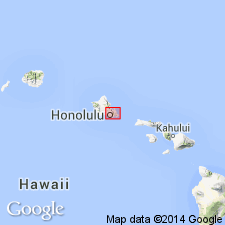
- Usage in publication:
-
- Ulupau tuff
- Modifications:
-
- Named
- Dominant lithology:
-
- Tuff
- AAPG geologic province:
-
- Oahu
Summary:
Named for Ulupau Head, tuff crater at north end of Mokapu Peninsula, [Mokapu quad] Island of Oahu. Composed of lavender gray, palagonitic tuff, Ulupau alluvium, and coral reef fragments. Is more than 500 ft. thick. Eruption assigned to before or during 40-ft. stand of sea.
Source: GNU records (USGS DDS-6; Menlo GNULEX).

- Usage in publication:
-
- Ulupau tuff*
- Modifications:
-
- Overview
- AAPG geologic province:
-
- Oahu
Summary:
Included in the lower part of Honolulu volcanic series. Diagrammatic cross section along coast of Ulupau Crater shows that unit underlies beach deposits of Waimanalo stand of sea. Assigned to Laie stand of sea. Assigned middle(?) and late Pleistocene age.
Source: GNU records (USGS DDS-6; Menlo GNULEX).

- Usage in publication:
-
- Ulupau Head tuff*
- Modifications:
-
- Age modified
- Areal extent
- AAPG geologic province:
-
- Oahu
Summary:
Ulupau tuff (Wentworth, 1926) is called Ulupau Head tuff as well as Ulupau tuff. "The dike-like mass near Mokapu landing and the northern outcrop of the 'Mokapu basalt' are nearer Ulupau Head.." "They are not necessarily Ulupau lava, but are so considered here", since neither tuff nor lava contain melilite. Tentatively assigned to Kahipa stand of sea based on fact that nip at 70-ft elevation shows tuff probably existed before Laie stand of sea. [See also Stearns, 1940, p.51.]
Source: GNU records (USGS DDS-6; Menlo GNULEX).

- Usage in publication:
-
- Ulupau Tuff†
- Modifications:
-
- Abandoned
- AAPG geologic province:
-
- Oahu
Summary:
Ulupau Tuff (Wentworth, 1926) is abandoned as formally named unit and renamed Ulupau tuff cone, informal unit of Honolulu Volcanics.
Source: GNU records (USGS DDS-6; Menlo GNULEX).
For more information, please contact Nancy Stamm, Geologic Names Committee Secretary.
Asterisk (*) indicates published by U.S. Geological Survey authors.
"No current usage" (†) implies that a name has been abandoned or has fallen into disuse. Former usage and, if known, replacement name given in parentheses ( ).
Slash (/) indicates name conflicts with nomenclatural guidelines (CSN, 1933; ACSN, 1961, 1970; NACSN, 1983, 2005, 2021). May be explained within brackets ([ ]).

